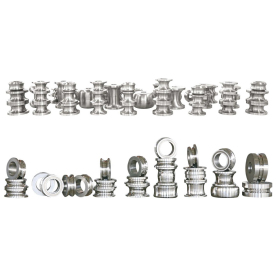****

Unlocking Efficiency: The Rise of Energy-Saving Induction Heating Equipment for Modern Industry Applications
In today’s fast-paced industrial landscape, energy efficiency has become a cornerstone of sustainable operations. As companies strive to reduce their carbon footprint and lower operational costs, energy-saving induction heating equipment has emerged as a revolutionary solution. This technology not only enhances productivity but also aligns with the global pursuit of environmentally responsible manufacturing practices.
Induction heating is a process that uses electromagnetic fields to produce heat within conductive materials. This innovative method is based on Faraday’s law of electromagnetic induction, which states that a changing magnetic field can induce an electric current in a conductor. Traditional heating methods, such as gas and resistance heating, often result in wasted energy as heat escapes into the environment or is not efficiently transferred to the workpiece. In contrast, induction heating equipment focuses energy precisely where it’s needed, minimizing waste and maximizing efficiency.

Unlocking Efficiency: The Rise of Energy-Saving Induction Heating Equipment for Modern Industry Applications
One of the standout features of energy-saving induction heating equipment is its ability to achieve rapid heating. Traditional heating methods can take time to reach desired temperatures, slowing down production processes. Induction heating equipment, on the other hand, can provide near-instantaneous heating, significantly accelerating operations. This rapid heating capability is essential in fast-paced manufacturing environments, where time equates to cost savings.
Moreover, induction heating equipment provides excellent temperature control. With advanced smart technology, operators can precisely control heat input and tailor heating patterns to specific processes. This level of control reduces the risk of overheating, ensuring that materials are heated uniformly and consistently. Whether in metal hardening, brazing, or other thermal processes, precise temperature management leads to improved quality and reduced waste.
Another compelling benefit of energy-saving induction heating equipment is its safety advantages. Traditional heating methods often involve open flames or hot surfaces, posing risks of burns and fire hazards. In contrast, induction heating generates heat directly within the material, leaving the surrounding area cool to the touch. This inherent safety reduces the risk of accidents, creating a safer working environment for employees.
Sustainability is a critical focus for industries aiming to enhance their corporate social responsibility. Energy-saving induction heating equipment is designed with sustainability in mind. It often utilizes less energy than traditional heating systems, resulting in lower greenhouse gas emissions. Additionally, the reduced energy consumption translates into lower utility bills, creating a dual benefit for businesses seeking to cut costs while operating sustainably.
The versatility of induction heating equipment further enhances its appeal across various industries. Whether in automotive, aerospace, electronics, or metal fabrication, induction heating can be applied to numerous processes such as forging, annealing, and melting. This adaptability makes it an indispensable tool for manufacturers looking to innovate and remain competitive.
Induction heating technology is continually evolving, with advancements aimed at increasing efficiency and capability. Manufacturers are incorporating IoT-enabled devices and AI-driven algorithms to create smarter induction heating systems. These innovations facilitate predictive maintenance, enabling operators to monitor equipment performance in real-time and schedule maintenance before issues arise. Such foresight ensures continuous operation and minimizes downtime, ultimately improving overall productivity.
While the initial investment in energy-saving induction heating equipment may be higher compared to traditional methods, the long-term benefits are substantial. Companies that adopt this technology often experience significant returns on investment through reduced energy costs, enhanced productivity, and improved product quality. Additionally, the ongoing emphasis on sustainability makes investing in induction heating not just a financial decision but a strategic move toward responsible manufacturing.

Unlocking Efficiency: The Rise of Energy-Saving Induction Heating Equipment for Modern Industry Applications
In conclusion, energy-saving induction heating equipment represents a transformative approach to industrial heating processes. By minimizing energy waste, enhancing safety, and providing precise temperature control, this technology aligns with the operational needs of modern manufacturers. As industries continue to pursue sustainable practices, the adoption of induction heating technology is likely to grow, shaping the future of energy-efficient manufacturing. By embracing these advancements, companies can position themselves at the forefront of innovation while contributing to a healthier planet.Scalable Pipe mill production line system



